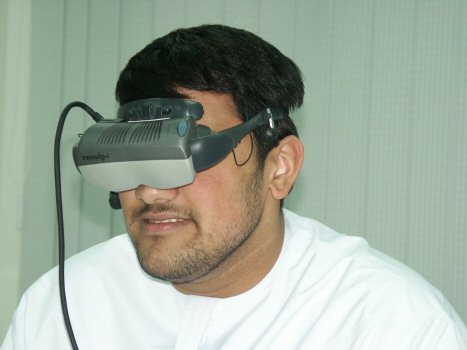
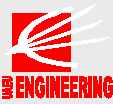
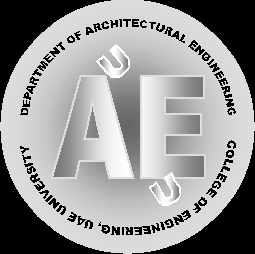
The UAEU Immersive CAVE (UAEU-CAVE)
|
UAEU-CAVE layout |
Contents: |
You
are visitor number
since 10/1/2004
|
Immersion using a head mounted display |
This page, the UAEU-CAVE, and the VR-LAB are still under construction and will remain so for some time. Please visit this page regularly to follow future developments. For comments or more information please contact Dr. Ahmad Okeil. Email: a.okeil@uaeu.ac.ae (Page first published on 26/12/2003, last updated on 29/9/2004).
|
|
Fish eye view |
The first CAVE (as well as the concept) was created by the faculty, staff, and students at the Electronic Visualization Laboratory (EVL), University of Illinois in 1992 and displayed at SIGGRAPH 92. Since then this back-projection method of virtual reality has gained a strong following. The concept consists of a room with graphics projected from behind the walls. The images on the walls are usually in stereo to give a depth cue. The main advantage over ordinary graphics systems is that the users are surrounded by the projected images, which means that the images are the users' main field of vision. This is usually called a "CAVE", CAVE Automatic Virtual Environment. It has obvious benefits: it is easy for several people to be in the room simultaneously and therefore see images together; and it is easy to mix real and virtual objects in the same environment. Also, because users see for example their own hands and feet as part of the virtual world, they get a heightened sense of being inside that world. People in the field believe that 100-140 CAVEs were built worldwide. An incomplete list of CAVES could be found at http://www.ncsa.uiuc.edu/VR/cavernus/users.html |
The CAVE environment can be used for everything from science to art, and from industrial simulations to education. A few important areas are listed below, but there are numerous examples and fields that can benefit from a 3D visualization environment.
· Scientific visualizations: In the scientific society, there is a trend towards 3D simulations. This has resulted in a rapidly growing need for 3D visualization of scientific data. CFD (Computational Fluid Dynamics) visualization is only one example.
· Visual simulations: There is also a growing need for visual simulations in industry. 3D simulations make it possible to test future products or to investigate otherwise unreachable environments.
· Education: Educational exercises were developed for CAVEs. Not only in the field of architecture but in many other disciplines as well. (see the work of George Francis on teaching mathematics using the CAVE).
· Architecture and city planning:: VR can be used in architecture and city planning, giving the opportunity to walk around in a building or city that has not yet been built.
· Art: There are many artistic applications for CAVE-like environments.
|
CAVE Applications in Architectural Education Good skills at envisioning three-dimensional spaces and forms from two-dimensional renderings are important requirements for students of architecture. The early introduction to the computer interface and an underdeveloped manual drawing ability leave many students with difficulties in expressing their ideas graphically using traditional presentation methods (pen, pencil, and brush). In the design studio, new tools are sought after to overcome this situation. Virtual reality tools are being increasingly used in design studios in many schools of architecture. The fundamental idea behind the three-dimensional immersive environment is to present the student with a perspective image, which changes as he navigates through his proposed design. In the CAVE the student feels the experience; not just sees it. The CAVE allows an instructor to walk through a design with his student and critique the design, discuss modifications, and leave behind markers with annotations to record specific suggestions for later design modification. A three dimensional model large enough to walk through could boost the student’s ability to conceive three-dimensional spaces and could make it easier for the student to understand something of what the instructor sees in his imagination. The CAVE also allows experimenting with new instructional concepts that are not currently possible with either traditional or CAD-based computer graphics techniques.
|
Approaching Notre-Dame-DuHaut
Walk Trough Remote Cities
Navigating through Villa Savoye
|
|
|
Why Design and Construct a CAVE? Turnkey CAVES are commercially available. The price for a standard 4 sided commercial CAVE (3 walls + floor) with stereo display is in the range of 300000 US$. Additional options may raise the price to 360000 US$. This price makes purchasing a turnkey CAVE beyond the budget of many educational institutions. Therefore, we decided to design and construct our own CAVE and to tailor it to fit our own needs at a very small fraction of the price of a commercial CAVE. |
Brief History of the UAEU-CAVE
The first proposal for establishing a VR-LAB at Department of Architecture, the United Arab Emirates University was submitted in May 2001. The first component of the VR-LAB (the UAEU-CAVE) is now operational. The first navigation through the UAEU-CAVE took place on Wednesday 24/12/2003. The 31 months were spent applying for approvals, securing funds, preparing the design, preparing specifications for different components, contacting suppliers, evaluating alternative components, collecting quotations, sending purchase orders, waiting for delivery, allocating space in our new building, modifying the design several times to adapt to changing conditions such as limited ceiling height for the selected location, carrying out assembly, developing software, aligning, fine tuning, and finally testing. After this long experience, building a second CAVE would not take that long :-).
History List:
May 20th, 2001 Fist proposal Submitted to the Department of Architecture, UAE University
December 24th, 2003 First successful navigation
January 6th, 2004 Fist student project on the CAVE
February, 14th 2004 First Course taught using the CAVE
January 4th, 2004 Article in ARCHNET. http://archnet.org/news/view.tcl?news_id=6301
February 19th, 2004 Article in Gulfnews. click here for article
I would like to thank Dr. Ramy El Diasty, Chairman of the Department of Architectural Engineering, Dr. J. Richard Williams, Dean of the College of Engineering, and Dr. Ali Rashed Alnoaimi, Deputy Vice Chancellor for Academic Affairs, the United Arab Emirates University for approving this project and for their continuous support. I would also like to thank Eric Marrane from EMI for his support in developing the software.
Planned Additions and Improvements
As of 26/12/2003, the UAEU-CAVE offers immersion and navigation through virtual 3D computer models. In the coming few weeks, it is planned to add the following features:
1- Connect additional input devices such as data gloves, space balls, user trackers, …etc,
2- Connect a head mounted display for single users,
3- Develop the software to allow manipulating objects in the virtual world,
4- Add a 5 channel sound system that can simulate acoustic phenomena in 3D,
5- Develop applications to serve in teaching different courses of architectural education (Design Studios, Interior Design, Advanced CAAD Applications, Perspective Drawings, Visual Studies, Building Acoustics and Illumination, Building Construction, History and Theory of Architecture, Urban Design, Architecture of Hot Arid Zones, …etc.). Courses in other disciplines could benefit as well.
6- Develop applications to demonstrate how to use the CAVE in consultations offered to the industry such as helping municipalities and planning departments in preparing for new developments and evaluating alternatives.
UAEU-CAVE Construction in Photos

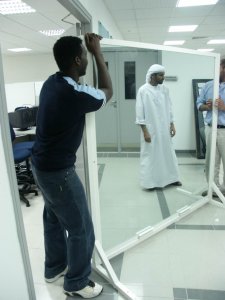
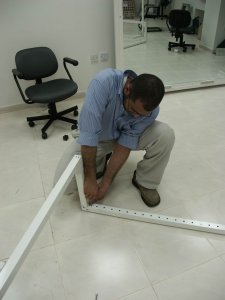



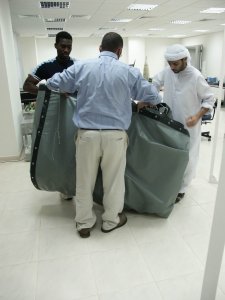
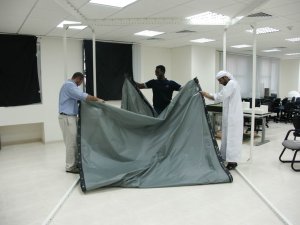
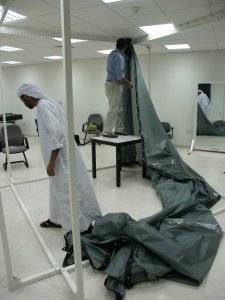
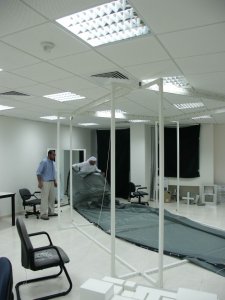
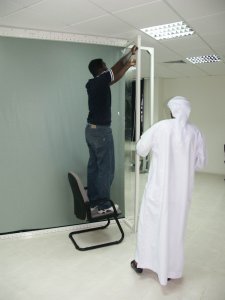
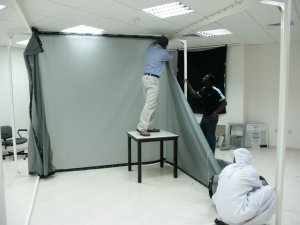
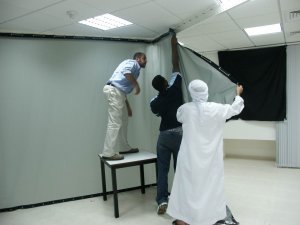
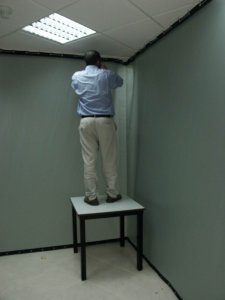
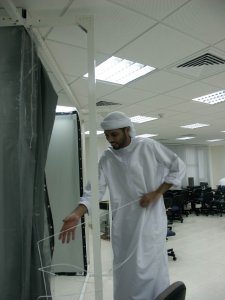


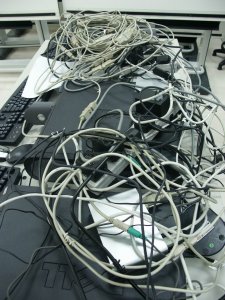
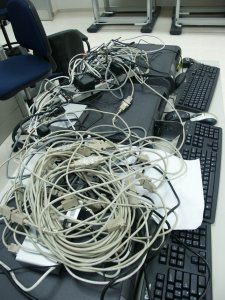




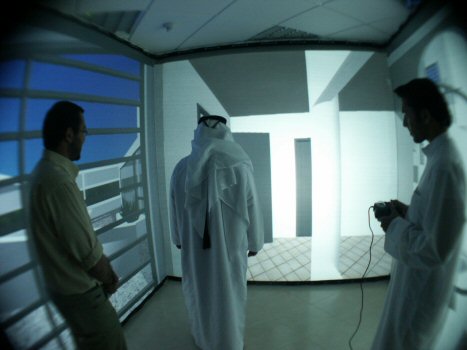
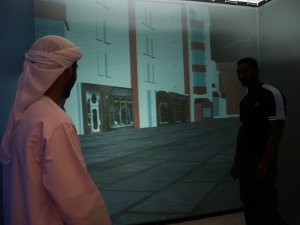
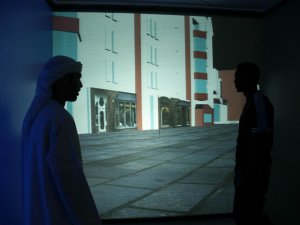
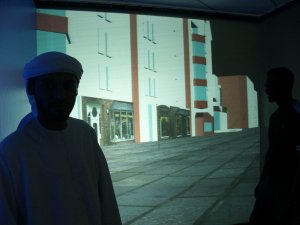

To download the movie select one of the following formats supported by your computer:
Cave-navigation AVI movie = 18.8 MB
Cave-navigation Quicktime movie = 12.5 MB
Cave-navigation MPEG movie = 8.5 MB
Cave-navigation MPEG4 movie = 6.5 MB
First Student Project in the CAVE
In the past few days students were allowed to enter the CAVE and navigate through ready made models. January 4th, after the final Design 2 jury, I asked four students if they would like to be the first students to put their design project on the CAVE. They said they would be happy to "sacrifice" two days from their winter recess. The Health and Sports Club Project was their second design project in a series of 5 design projects before taking the graduation project. The design project was developed in a traditional design studio setup but they presented their final work drafted on Autocad in 2D. The four students never had any serious 3D modeling course before. I made it clear that a sketchy model is adequate as a first experiment. After two days they came back with the model shown below. It was an Autocad 3D model around 400kb in size. After taking several tours through the model they said they would like to continue working on the itl next semester (no sacrifice this time) by adding furniture, proper lights, landscape and contours of the mountain surrounding the project. After the virtual tours some amazing statements were made.
Statement from a student: Had I known, how thrilling it is, to move in a building I designed, I would have made a bigger effort to achieve a better experience.
My comment: This is a statement I never heard from a student in my entire life as an educator. I am used to hearing from the students that they made all they can do and that they deserves the highest grade possible.
Statement from an instructor: I feel your design project has developed in the past two days.
Student replies: We changed nothing since you last saw it!!!!!
Another Instructor: This thing is so real and I ask myself if in the future there will still be place for IMAGINATION.
My question: Can VR really kill imagination or could it take it to unprecedented horizons? A good topic for a research paper.


Basem Alnamer takes us in a tour inside the Sports and Health Club. He gets so excited, walks too fast, hits walls some times and argues about design mistakes. Suddenly the blue screen savers start. In another tour he discovers that stepping into the empty elevator shaft takes him directly to the garage in the basement. Conclusion: Elevator shafts need doors.


The Model was unfurnished so we had to take real chairs with us. From left to right: Ahmad Alikhan, Mohammad Al Zarouni, Ahmad Okeil, and Rashed Al Kaabi.
To download the movie, select one of the following formats supported by your computer:
first-student-model AVI movie = 7.68 MB
first-student-model Quicktime movie = 9.78 MB
first-student-model MPEG4 movie = 6.72 MB
Reutlingen, First Virtual City Displayed in the CAVE
CyberCity AG. (http://www.cybercity.tv/), a leading firm in the 3D visualization of cities and the authorities of the German city of Reutlingen have kindly agreed to send the 3D model of Reutlingen to be displayed in the UAEU-CAVE for academic and demonstration purposes. A group of UAE students will make their first virtual visit to Reutlingen in the last week of February after the semester begins. A report about their experience will be posted here.
UAEU-CAVE Participates in the UAE-IT Challenge
The UAEU-CAVE is participating in the UAE-IT Challenge (http://www.uaechallenge.com). This unique national challenge for the UAE is an awards and exhibition program designed to recognize and harness the best IT based ideas and practices from the classrooms of secondary schools, colleges and Universities of the UAE. More information about the CAVE entry at http://www.uaechallenge.com/pview1_2004.asp?ProjectID=673
First Course to Use the CAVE
A group of graduation students registered in the course "Selected Topics in Architecture" started using the CAVE this semester. Their experience in using VR in the development and presentation phases of their graduation projects will be monitored.
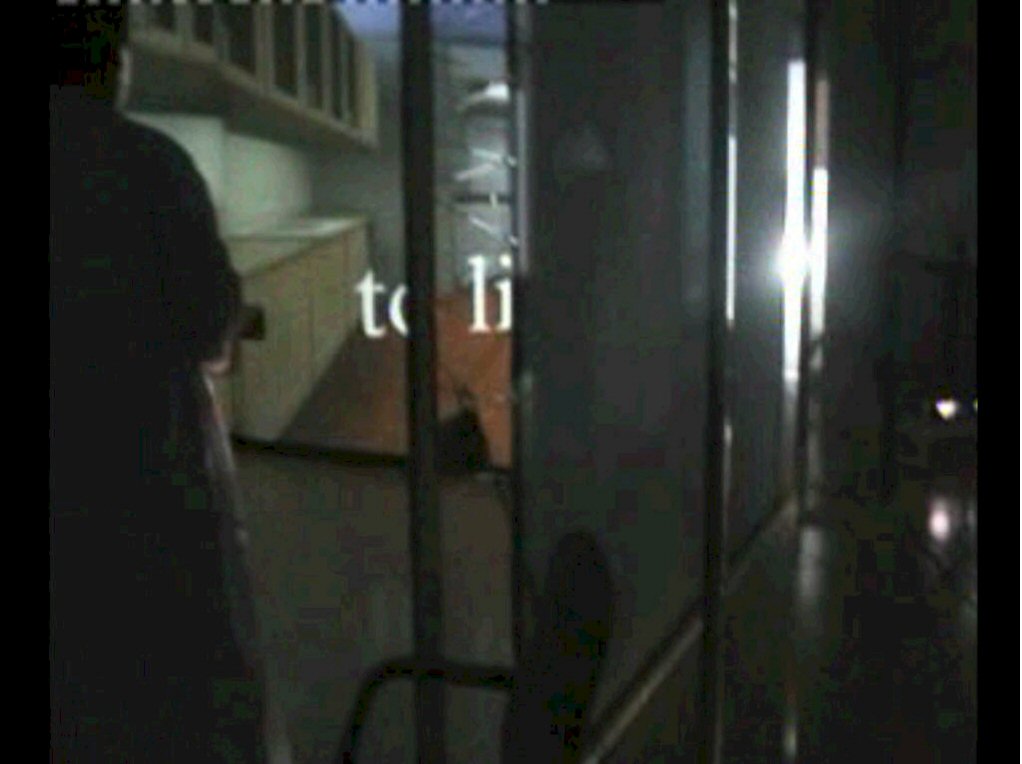
To download the movie, select one of the following formats supported by your computer:
cave-concept MPEG movie = 36.4 MB
To be continued…….
For comments or more information please contact Dr. Ahmad Okeil. Email: a.okeil@uaeu.ac.ae

